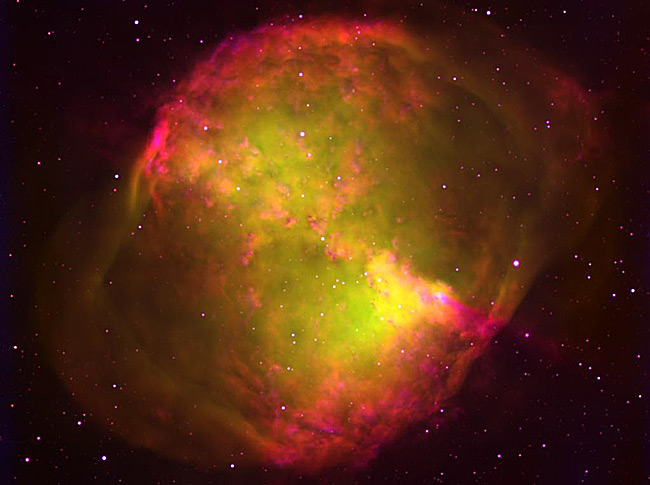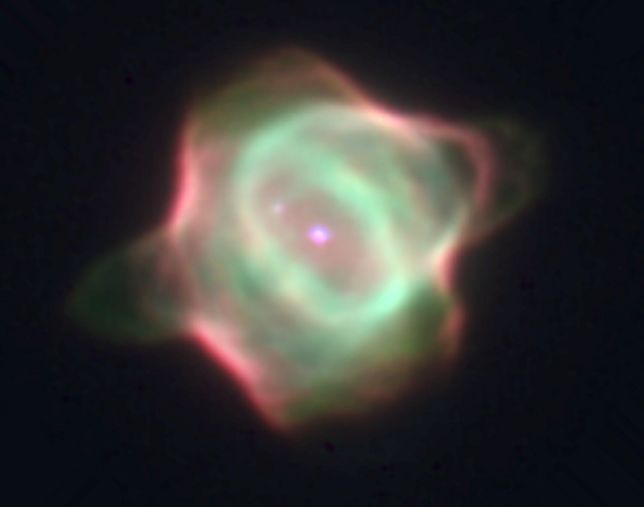Astronomy Picture of the Day
Discover the cosmos! Each day a different image or photograph of our fascinating universe is featured, along with a brief explanation written by a professional astronomer.
Posted on 07/25/2003 5:25:49 AM PDT by petuniasevan
Discover the cosmos! Each day a different image or photograph of our fascinating universe is featured, along with a brief explanation written by a professional astronomer.
Explanation: In 1764, French astronomer Charles Messier sighted this gorgeous cosmic cloud which he described as an oval nebula without stars. Cataloged as M27, it is now popularly known as the Dumbbell Nebula, not for its substandard academic performance but for the elongated shape, like a bar with weights on each end, which first caught Messier's eye. This deep image of the bright planetary nebula does reveal the Dumbell's central star though, and an array of foreground and background stars toward the sly constellation Vulpecula. The picture is a composite that includes 8 hours of exposure through a filter designed to record only the light of hydrogen atoms, tracing the intricate details of the nebula's faint outer halo which spans light-years. Thought to be an example of the fate awaiting our own Sun 5 billion years hence, the Dumbbell Nebula is about 1,200 light-years away.

The Dumbbell Nebula in Hydrogen and Oxygen

M27: The Dumbbell Nebula
Dumbbell Nebula M27 in constellation Vulpecula
| Right Ascension | 19 : 59.6 (h:m) |
|---|---|
| Declination | +22 : 43 (deg:m) |
| Distance | 1.25 (kly) |
| Visual Brightness | 7.4 (mag) |
| Apparent Dimension | 8.0x5.7 (arc min) |
Realize that these are long-exposure images. At the eyepiece of, say, an 8-inch 'scope, you will probably see something like this (but probably fainter):


Planetary nebulae frequently contain great arcs of matter that are denser than the surrounding nebula. This is an important clue about how the nebulae are formed. The standard explanation of planetary nebula formation suggests that these stars are at the end of life, and shed their outer layers in the process of becoming white dwarf stars.
If this were the case, one would expect the nebulae to be more uniform and spherical as the outer gas layers are blown out into space.
It is well known that most star systems have more than one star. When stars (or planets) pass too closely (within the Roche limit) to each other, the more massive body can pull matter from the surface of the less massive body. In the case of a main sequence star there is great internal pressure that helps to eject the surface material when the stellar companion passes close by. Some of the ejected matter may accrete onto the companion, and the remainder is blown outward by the solar wind, forming the dense arcs that we see.
This is illustrated in the picture below. Note the central star, and it's companion (northwest of the central star). There appears to be a faint trail of material (green) dragging behind the companion that leads toward the northeast. This appears as if the companion is in an elliptical orbit and moving counter clockwise around the central star as viewed in this image of the New Born Nebula.

Planetary nebulae may be more of an indicator of close orbits than stellar age.
Disclaimer: Opinions posted on Free Republic are those of the individual posters and do not necessarily represent the opinion of Free Republic or its management. All materials posted herein are protected by copyright law and the exemption for fair use of copyrighted works.